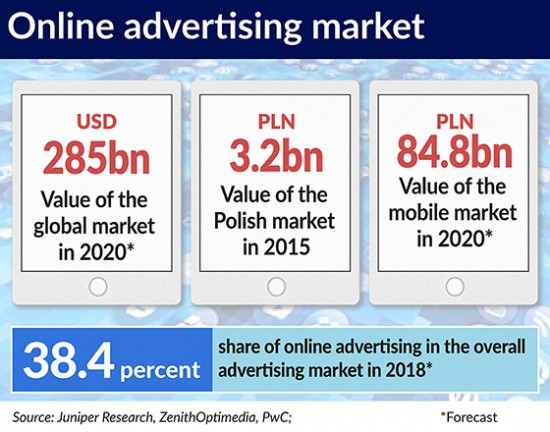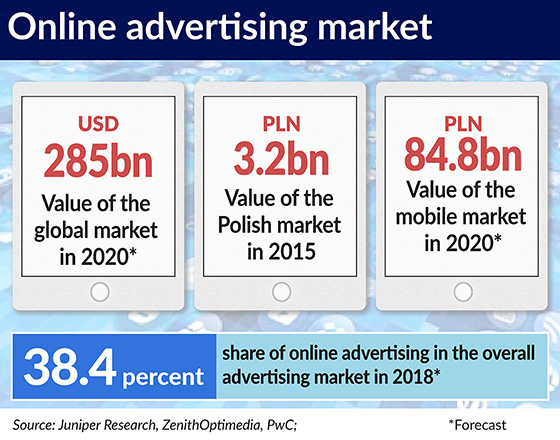
(Esther Vargas, CC BY-SA)
In five years, the global online advertising market will be worth a little over USD260bn or 69 per cent more than in 2015 ‒ claims the PwC in its annual report on the market and entertainment media. The analysts of Juniper Research have even bolder predictions. They forecast that the market will increase by 78 per cent, to USD285bn. Despite some divergence as to the scale and pace of growth, it is clear that the expectations of the experts are optimistic.

Juniper Research believes that the money spent by advertisers on the internet will go primarily to those who will be able to more accurately adapt the advertising to the preferences, interests and needs of specific target audiences. This precision in the delivery of advertising is guaranteed by companies which ‒ like Facebook or Google ‒ have spent years collecting information about the users. These two companies are the biggest players in the market of internet advertising. In 2015, Facebook had USD17.1bn in revenue from that source, and Google, the world’s largest player in the internet advertising market, had revenues of USD67.4bn.
The rapid increase in the value of the internet advertising market will lead to the growing importance of this segment in the total advertising expenditures. The ZenithOptimedia (ZOM) agency forecasts that in just three years the internet’s share in the global advertising market will grow from 29.9 per cent in 2015 to 38.4 per cent in 2018.
In 2015, the value of the Polish internet advertising market increased by a little over 20 per cent, to nearly PLN3.2bn. This is the fastest pace of growth since 2011, when the market increased by 23 per cent. PwC Poland announced that it would present the forecasts for the Polish online advertising market in August. ZOM is predicting that this year the Polish internet advertising market will grow by 12 per cent.
In a year the internet will overtake TV
According to PwC, as early as next year, the value of the global internet advertising market will exceed that of television advertising, which currently has the largest share of the advertising pie. In Poland, this is still a more distant future. In its statement P4, the operator of the Play mobile network, which is one of the largest advertisers, says that its advertising expenditures on the internet will match those on TV in two years.
PwC emphasizes that the potential of the internet advertising market is not fully utilized, and the reason is that internet users are using solutions which allow them to block advertisements (so-called adblockers). Juniper Research expressed a similar opinion. Across the world adblockers are used by 200 million desktop users (in Poland ‒ more than 1/3 of all desktop users) and more than 400 million users of mobile internet (according to the PageFair company), which means that ads are blocked on every fifth smartphone.
The British consulting firm Ovum believes that by 2020 the blocking of ads will decrease the value of the world advertising market by up to USD78bn. In the most optimistic scenario, in which Ovum analysts assumed that advertisers will be able to adapt the advertising and its delivery to the expectations of online consumers, the decrease could only amount to approximately USD17bn.
The internet users’ fatigue with graphic ads, which is manifested in their blocking, leads to the growing popularity of native ads and the emergence of new ideas. According to the company Adyoulike, global expenditures on native advertising will amount to more than USD59bn in 2018, while in 2015 they amounted to less than USD31bn.
In North America, the market is expected to increase from USD11.5bn to USD22.6bn, and in Western Europe from USD7.1bn to USD13.9bn, while in Eastern Europe from USD1.4bn to USD2.7bn (out of which in Russia there will be an increase from USD0.7bn to USD1.3bn).
One example of the search for new ways to place ads is the offer of the Snapchat social networking site. It allows advertisers to introduce their own names of photo filters which are offered to the users. This way of advertising is tested, among others, by Taco Bell, Nike and General Electric. Such advertising is not cheap. The daily cost is up to USD750,000 but as Marisa Thalberg, the head of marketing at Taco Bell, told “Wall Street Journal”, its effectiveness is surprisingly high.
The mobile leap
PwC expects further dynamic growth of mobile advertising. This is a result of the changes in the way people use the internet and the migration of users from stationary to mobile devices. The value of the global mobile advertising market in the years 2015-2020 is supposed to increase at an average annual rate of 19.6 per cent, and reach USD84.8bn at the end of that period. In global terms, mobile advertising will then account for 32.6 per cent of the internet advertising market.
In Poland, in the last year 16 per cent of the total internet advertising expenditures was allocated to mobile advertising. PwC forecasts concerning the United States, which is the largest advertising market in the world, indicate that in 2020 mobile advertising will be responsible for more than 49 per cent of the revenues from online advertising, which are estimated to reach USD93.5bn. In 2015, these figures were, respectively, slightly below 35 per cent and USD59.6bn.
The forecasts of the ZenithOptimedia media agency are even more optimistic. ZOM estimates that as early as next year the value of mobile advertising in the world will reach USD99.3bn, following an increase by 29 per cent, and will be almost USD2bn higher than the value of advertising on personal computers.
Along with the expected significant increase in the consumption of video content by users of smartphones and tablets – according to the forecasts contained in this year’s edition of the “Cisco Visual Networking Index” the value of the mobile advertising market will increase by more than 11 times in the years 2015-2020 – there is an expectation of rapid growth in mobile video advertising. The biggest beneficiaries will be first and foremost Facebook, YouTube (owned by Google), as well as Snapchat and Twitter.
According to forecasts of PwC, in the United States, already this year the value of video mobile advertising will be higher than the value of video advertising for stationary devices. Between 2015 and 2020, the value of the mobile video advertising market will increase from USD3.5bn to USD13.3bn. This will be driven, among other things, by the increasingly high speed of mobile internet, which reduces the loading time of the ads and improves the smoothness of the playback.
In the case of mobile video ads, great hopes are placed in the cellular networks operating in the 5G technology, which should improve the parameters associated with the playback of the ads. As a result, the supply of mobile video ads should increase after 2020, when the emergence of the first commercial 5G networks is expected.



